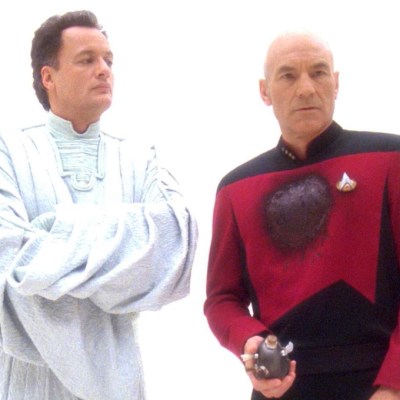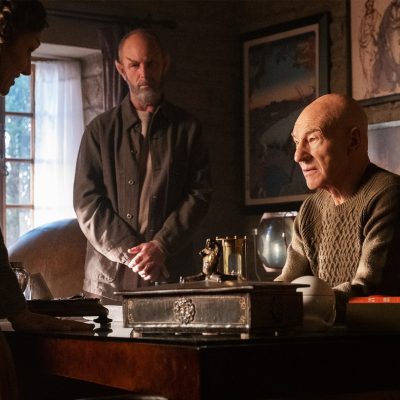Star Trek: The Rise, Fall and Rise Again of Planet of the Week Storytelling
With Star Trek: Strange New Worlds promising a return to the planet of the week structure, we trace the evolving history of Gene Roddenberry's original pitch across sci-fi TV
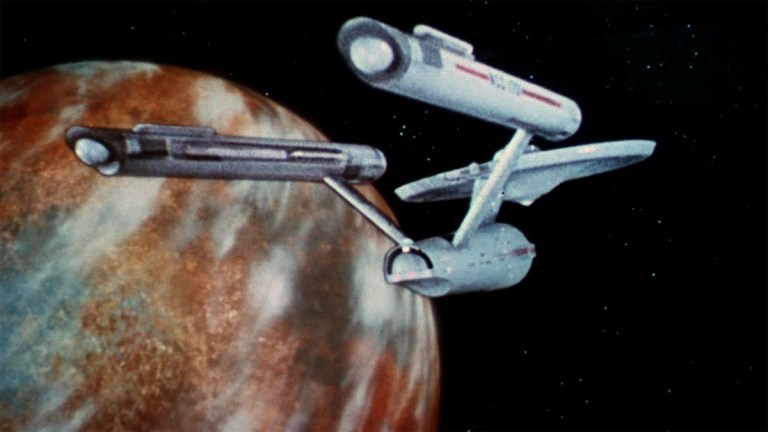
It’s 1964, a couple of years since President John F. Kennedy announced that the USA was going to land on the moon. It was also the year that saw ground-breaking science fiction anthology series The Twilight Zone come to an end. The series had become a household name by telling self-contained, high concept stories written by leaders in the genre. Not just the endlessly talented Rod Serling, but names like Charles Beaumont, Richard Matheson, and Ray Bradbury. It also starred up-and-coming acting talent such as William Shatner, Leonard Nimoy, and George Takei.
As well as bringing talent to the field, The Twilight Zone was also notable for using science fiction allegory as a way to talk about political and social issues that advertisers and censors would otherwise not touch with a ten-foot pole.
In steps Gene Roddenberry, with a concept he describes as “a wagon train to the stars.” His opening pitch is “Action – Adventure – Science Fiction. The first such concept with strong central lead characters plus other continuing regulars.” In other words, fitting neatly into the niche left by The Twilight Zone, while bringing with it the marketability of a recurring cast.
The heroes of this series, the crew of the S.S. Yorktown, would visit alien planets, but not too alien, as Roddenberry himself points out:
“The “Parallel Worlds” concept is the key…
…to the STAR TREK format. It means simply that our stories deal with plant and animal life, plus people, quite similar to that on earth. Social evolution will also have interesting points of similarity with ours. There will be differences, of course, ranging from the subtle to the boldly dramatic, out of which comes much of our colour and excitement. (And, of course, none of this prevents an occasional “far out” tale thrown in for surprise and change of pace.)”
At which point Rodenberry probably noticed he liked the sound of that split infinitive. The purpose of the “Parallel Worlds concept” was to make “production practical by permitting action adventure science fiction at a practical budget figure via the use of available “earth” casting, sets, locations, costuming, and so on” but also to “keep even the most imaginative stories within the general audience’s frame of reference.”
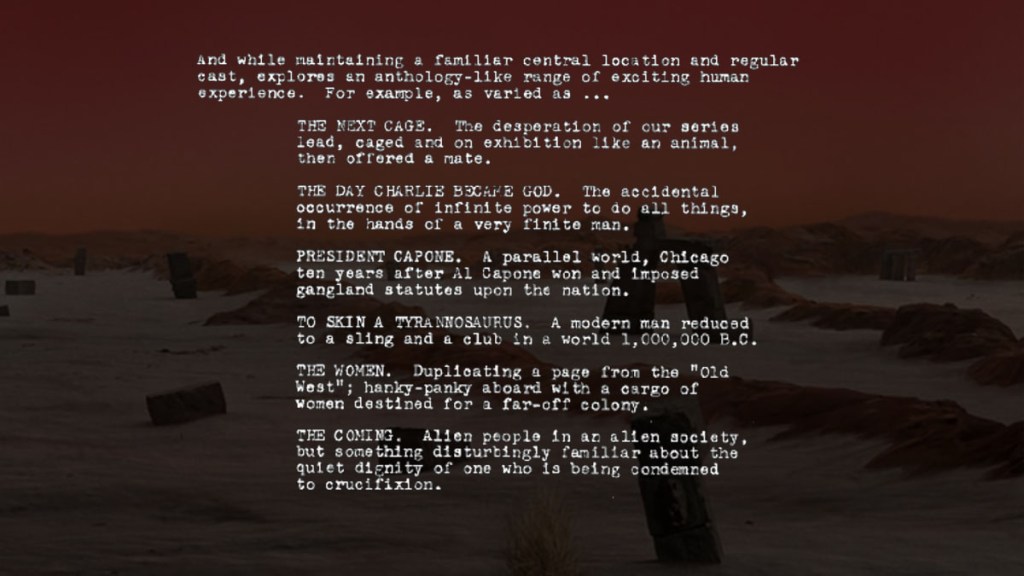
In that opening pitch, which you can find at the Ex Astris Scientia fan site here, Roddenberry drops a number of potential story pitches. Some of them, like “President Capone,” would eventually find their way into episodes of the series. Others, like “Kongo,” which promised a race-switched portrayal of “the Ole Plantation days,” perhaps thankfully never materialized.
The idea of visiting a different planet every week allowed the show to keep telling “Twilight Zone-ish” anthology stories, while maintaining a recurring cast, in the same way a detective show could feature a different murder every week. It also meant, at a time when syndication was an important part of any show’s income, that episodes could be shown in pretty much any order without confusing the audience.
The series was successful, then less successful, then cancelled to the upset of a collection of vocal hardcore fans.
It spawned imitators. Blake’s 7 and Space: 1999 were darker, weirder, and more British than Star Trek, and more tied into their own long-term narratives, but both still featured plenty of stories where the characters arrive at a planet and encounter weird stuff. Battlestar Galactica, while trying very hard to be Star Wars, was also no stranger to the planet of the week.
Roddenberry tried to relaunch Star Trek a few times. First as Star Trek: Phase II, then an unrelated series called Starship, then a movie, until eventually striking gold with Star Trek: The Next Generation.
The Next Generation
After an, admittedly, rocky start, The Next Generation took the Star Trek concept further than ever before, and over seven series elevated “planet of the week” to almost a philosophy procedural. Over time, it did things the original Star Trek could never do, introducing character arcs and long-term storylines, such as the Borg, or Data’s growing humanity.
Even in the show’s Writers’ Bible, we can see how the Star Trek concept has been refined. It specifically lays out “We are not buying stories which cast our people and our vessel in the role of “galaxy policemen” and “We are not in the business of toppling cultures that we do not approve of.” It also narrows the focus. No more “Earth where Rome never fell” stories, instead, saying “Plots involving a whole civilization rarely work. What does work is to deal with specific characters from another culture and their interactions with our own continuing characters.”
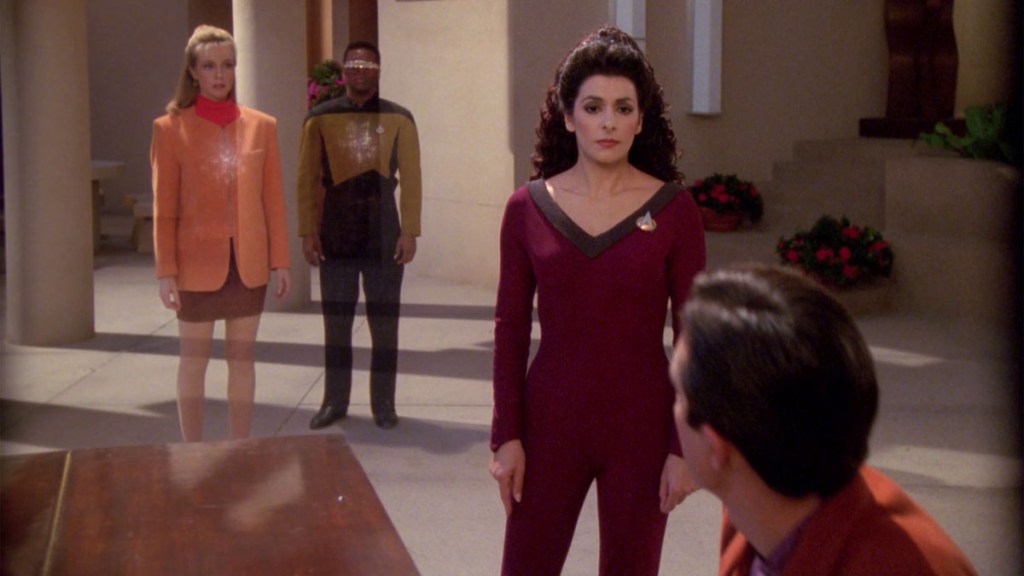
In its planet-of-the-week stories it hit some of the old stand-bys, such as The Planet Where There Is No Crime But The Only Sentence Is Death, or Racist African Stereotype Planet, in admittedly not classic episodes, but also gave us stories such as “The Masterpiece Society,” which not only gave us a look at a hypothetical world where everybody does the job they are born for, but also asks uncomfortable questions about how the Enterprise should interact with these cultures, a theme we see prop up again in “First Contact” (not the movie) and “Who Watches the Watchers?“
It also gave us “The Outcast,” an episode that, while it’s dated extremely poorly, was at least trying to address the prejudices of the time (and may have done so more successfully if Frakes had got his wish of the gender-neutral alien love interest being played by a male actor).
Star Trek: The Next Generation was an enormous success, and success breeds imitators.
The Planet of the Week’s Golden Age
Red Dwarf started out as an entirely different sort of beast to Star Trek, replacing military and scientific heroes with chicken soup machine repairmen, and space adventures with bunk bed comedy that just so happened to be set aboard a spaceship. But as the series developed they would encounter waxwork museum planets, psi-moons that replicated your inner psyche, planets like ours but everything runs backwards (later remade as Tenet), and a world where everyone was Arnold Rimmer.
The mid-nineties to early noughties were a golden age for planet of the week TV.
Star Trek: The Next Generation itself would inspire several spin-offs, including Star Trek: Voyager and Star Trek: Enterprise, as well as Star Trek: Deep Space Nine (which we’ll come to later).

The movie Stargate was spun-off into the TV series Stargate: SG-1, using the film’s premise to make a planet of the week series that a) saved money on expensive spaceship footage – until they decided they wanted to do that anyway – and b) handily explained why all the alien cultures looked extremely human. That series itself would eventually spin off two other series and a handful of TV movies.
Farscape took the Planet of the Week setup and decided to get real weird with it, taking full advantage of the creativity of the Jim Henson Creature Workshop to give us aliens that were far more than a funny-looking forehead, and storylines that were far more complex and messy than the clean cut Star Trek universe would typically allow. At the same time, while planets of the week weren’t a rarity, Farscape’s episodes would frequently bleed together into overarching single plotlines. Sliders, meanwhile, would abandon spaceships entirely, taking Roddenberry’s original “parallel worlds” pitch to its logical extreme.
Even Gene Roddenberry’s unused ideas were being mined for potential ideas, with Gene Rodenberry’s Andromeda giving us a series about a Definitely Not The Federation Starship getting thrust into the future to discover the Definitely Not The Federation has fallen and the galaxy is in disarray (an idea that might sound extremely familiar to modern Star Trek fans).
But while space shows were in a boom, two shows in particular were already adding twists to the formula that could spell doom for the Planet of the Week.
Bringing the Strange New Worlds to You!
As The Next Generation was getting ready to end on a high, two series were closing in on a way to replicate its success. There is some debate about how much these two creative teams arrived at the same solutions in parallel, or if there was some cross-pollination, but either way, the thinking was the same.
The most expensive thing about planet of the week shows was, basically, the planet. You could creatively reuse props and costumes, but each world needed its own backdrops, scenery, alien makeup, and more. What if you could do Planet of the Week but without the planet?
And so we saw Star Trek: Deep Space Nine and Babylon 5 emerge. Instead of a spaceship, the setting was a space station, and instead of visiting a different planet every week, the adventure would come to them in the form of alien visitors and clashes among the native alien populations of the station.
The station brought with it other implications as well. No longer would the characters be able to fly away at the end of the episode, never thinking again about the chaos they left in their wake. These characters would have to live with the consequences of their actions, with the effects returning on them again and again.
Both Deep Space Nine and Babylon 5 started out with storylines that seemed like fairly straight forward Star Trek-style fare, but over time these long-term plotlines would build up. Both space stations soon found themselves facing a mysterious new threat, and the outbreak of a galaxy-wide war.
As the necessity for one-and-done storylines fell out of vogue, writers felt more freedom to produce these ongoing storylines.
These series, alongside Space: Above and Beyond paved the way for yet more serialised storytelling in the form of a new, rebooted Battlestar Galactica. This version was no Star Wars knock-off, and had no interest in planets of the week. While it was set on a fleet of ships, Battlestar Galactica was less interested in the planets those ships were flying by than in the relationships between the people aboard those ships, and their battle with the pursuing Cylons.
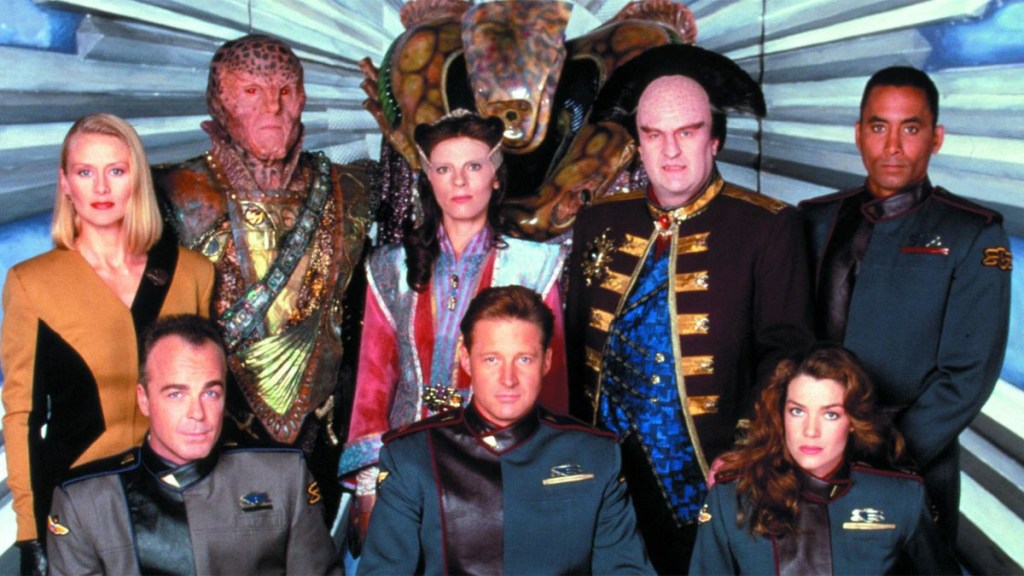
At the same time, a feeling was spreading that bobbly forehead aliens looked a bit silly, and stories became decidedly human centric. Firefly straddled the gap between episodic and serialized, in much the way Joss Whedon’s Buffy the Vampire Slayer had done before it, but every character in it was human, and every planet (or often, moon) they visited was a human colony, more often-than-not, a desert one with a decidedly Wild West aesthetic.
Star Trek: Enterprise became the first Star Trek since the original to get canceled, and the first not to have a successor series immediately lined up.
By 2010, the only series about spaceships visiting alien planets was Stargate: Universe, and even that show was more interested in the inter-character drama among the ship’s crew than in the planets they were popping in on along the way.
Even J.J. Abrams’ new Star Trek movies were less interested in strange new worlds, than in preventing attacks on Earth. Star Trek Into Darkness climaxes with Spock having a fist fight with someone on the roof of a rubbish truck in a really quite modern-looking San Francisco.
For a while, spaceships just weren’t something you found on TV. In 2014, the only space TV show on air, Ascension, turned out to actually be about a bunch of people who only thought they were on a spaceship, but were actually in a massive simulator.
Space Gets Cool Again
Then Abrams got the job that, frankly, judging from his Star Trek movies, was the one he had wanted in the first place. He got to make the new Star Wars movie. It came quickly in the wake of the heavily Farscape-aesthetic wielding Guardians of the Galaxy (Ben Browder, Farscape’s John Crichton, would later say “When I met James Gunn, I introduced myself and he said ‘I know who you are.’ And I said ‘Yeah, I thought you did because I saw your movie, bro.’”)
Around the mid-2010s, there seems to be a tipping point, where people finally have their fill of the post-apocalyptic and are suddenly very keen to get back to space.

In TV land James S.A. Corey’s The Expanse novels were being adapted into a TV series in an attempt to create the fabled “Game of Thrones in space.” That was quickly joined by the more cheap and cheerful space-bounty-hunter series, Killjoys, and space reformed-mercenary series, Dark Matter.
But with the exception of The Expanse’s protomolocule, we had yet to see many aliens on TV, with less interest in exploring alien worlds than in space crimes and interplanetary/stellar scale politics and warfare.
In 2017, when Star Trek, finally, returned to the small screen, we were given a series that involved less traveling to previously unexplored alien worlds, instead giving us a long-term plotline about the Federation’s war with the Klingons.
And yet old-style Trek stories were starting to make a comeback. Seth MacFarlane’s The Orville was marketed as a space spoof akin to a live action Space Family Guy, or something in the mould of Galaxy Quest. What viewers actually got was a remarkably faithful homage to the Star Trek of the nineties. Over two seasons it’s given us planets where the female gender is outlawed, where everything is decided by social-media vote (an extremely “successful white male comedian who’s worried about getting cancelled” form of social commentary), and a planet where everyone born under a certain star sign is put in camps. It’s a series that might not quite reach the heights of the stories it’s aspiring to be like, but it is clear about the sort of stories it wants to tell.
At the same time, planet of the week stories were coming from another unexpected direction, in the form of Rick & Morty. From its Purge Planet episode (that directly references Star Trek’s own ‘Red Time’, to the culture of civilized facehuggers, one thing Rick & Morty excels at is taking a big idea, playing with for the length of a story, and then putting it back in its box.
So while Star Trek: Discovery was followed up by the equally plot-arc-heavy (although extremely welcome) Star Trek: Picard, perhaps it wasn’t surprising that the third new Star Trek spin-off was an animated series written by Rick & Morty writer Mike McMahan.
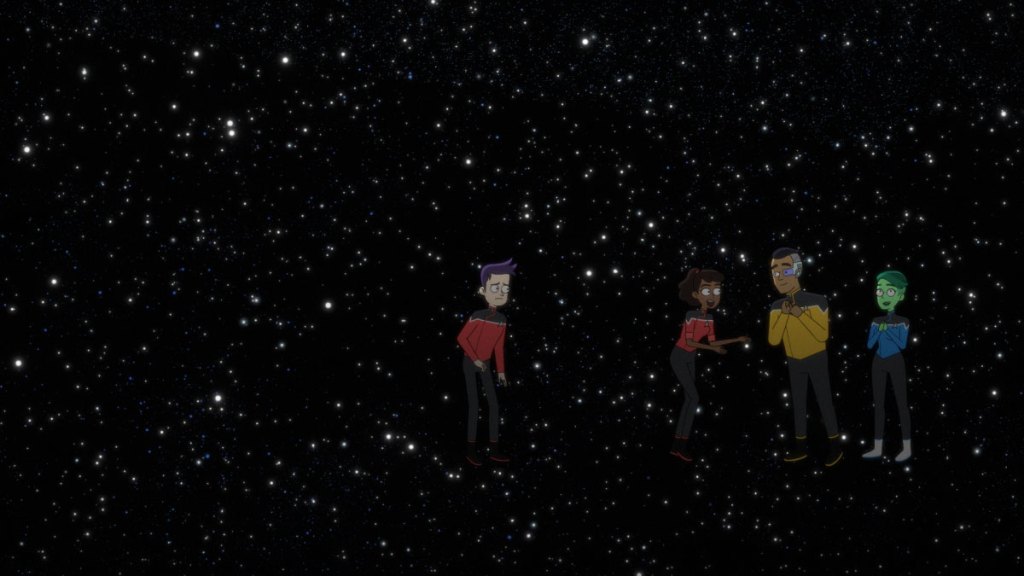
Despite being a comedic take on the franchise, Star Trek: Lower Decks still feels more like “old” Star Trek than its franchise-mates. It features a big orchestral theme tune and an opening credit sequence with the ship flying past various planets. Its plots involve rescuing ancient cryogenically frozen colony ships, space zombies, extremely crystal-themed planets, and massive alien trials that actually turn out to be surprise parties.
Star Trek: Discovery, meanwhile, seems to have been taking the long way round to its planet of the week roots. Its second season gave us a look at the culture of Commander Sarus’ home planet (along with some very dodgy prime directive violations) and a planet of humans abducted from Earth’s World War III. Its third season saw the Discovery thrust into the future to discover the Federation has fallen and the galaxy is in disarray, allowing us the peculiar pleasure of seeing a Planet of the Week episode where the planet in question was Earth. Now that Michael Burnham is a Captain, and the ship is reunited with the remnants of the Federation, we may actually see some actual exploring next season.
Even Star Wars, which has never really been at home in this particular sub-genre, has given us The Mandalorian. Despite the ongoing plot, every episode of the Star Wars series features the Mandalorian (I refuse to remember his actual name) riding into town on a new planet with a drastically different biome and inhabitants, having an adventure, and then riding off perpendicular to the sunset.
And now we come full circle. Because as well as its own sideways edging towards Planet of the Week stories, Star Trek: Discovery has also introduced Captain Pike, the Captain of the USS Enterprise introduced in Star Trek’s original pilot. He, his first officer “Number One”, a new Spock (the third, if you’re counting) and their much shinier looking Enterprise NCC-1701-No-Bloody-A-B-C-or-D proved so popular with fans that they have been given their own series.
The description of Star Trek: Strange New Worlds sounds… familiar.
Executive producer Henry Alonso Myers describes it as “We want to do Star Trek in the classic mode; Star Trek in the way Star Trek stories were always told. It’s a ship and it’s traveling to strange new worlds and we are going to tell big ideas science fiction adventures in an episodic mode. So we have room to meet new aliens, see new ships, visit new cultures.”
It sounds like a pretty good idea.
Chris Farnell has written his own series of planet-of-the-week style novellas, Fermi’s Progress, about a prototype FTL ship that has the unfortunate side-effect of blowing up every planet in its wake. You can find the first one, Dyson’s Fear, here, or get the season pass from Scarlet Ferret.

